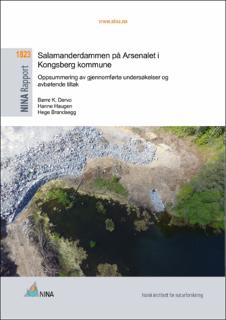Salamanderdammen på Arsenalet i Kongsberg kommune. Oppsummering av gjennomførte undersøkelser og avbøtende tiltak
Research report

Åpne
Permanent lenke
https://hdl.handle.net/11250/2656332Utgivelsesdato
2020Metadata
Vis full innførselSamlinger
- NINA Rapport/NINA Report [2303]
Sammendrag
Dervo, B.K., Haugen, H. & Brandsegg, H. 2020. Salamanderdammen på Arsenalet Kongsberg kommune. Oppsummering av gjennomførte undersøkelser og avbøtende tiltak. NINA Rapport 1823. Norsk institutt for naturforskning.
Av totalarealet på 34 500 m2 rundt tjernet på Arsenalet i Kongsberg kommune, har utfyllingen redusert arealet med salamanderhabitat (vann, godt og middels godt til dårlig landhabitat) med 5 900 m2 (23 %). Gjennom habitattiltak er tapet av vann- og godt landhabitat redusert, og nedgangen for disse arealkategoriene er estimert til 1 200 m2 (10 %).
Totalt ble det fanget 193 småsalamander og 23 storsalamander under rusefangsten i tjernet. Det tilsvarer en fangst per rusetime (CPUE) på henholdsvis 0,192 og 0,022 for de to artene. Antall individer fanget pr arealenhet av de to salamanderartene på Arsenalet er som gjennomsnittet for store salamanderlokaliteter i kulturlandskapet på Østlandet.
Resultatene fra de ulike genetiske analysene peker i retning av at tjernet på Arsenalet er mer utsatt for negative effekter av isolasjon, sammenlignet med dammene på Notodden. Det er særlig underskuddet av heterozygote som viser dette.
Alt tyder på at tjernet på Arsenalet fortsatt har en relativt livskraftig bestand av både stor- og småsalamander. Trolig vil habitattiltakene som er gjennomført i stor grad kompensere for tapet av arealer som skyldes utfyllingene. Det som gir mer grunn til bekymring er de langsiktige effektene av den genetiske isolasjonen. Allerede nå er denne målbar, selv om omfanget fortsatt er litt usikkert. Bestanden vil være svært utsatt for genetisk drift. Skal bestanden overleve på sikt vil det trolig være nødvendig med støtteutsettinger. Dervo, B.K., Haugen, H. & Brandsegg, H. 2020. The newt pond at the Arsenalet in Kongsberg municipality. Summary of completed surveys and mitigation measures. NINA Report 1823. Norwegian Institute of Natural Research.
Of the total area of 34,500 m2 around the pond at Arsenalet in Kongsberg municipality, the filling has reduced the area of newt habitat (water, good and medium good to poor land habitat) by 5 900 m2 (23%). Through habitat measures, the loss of water and good land habitat has been reduced, and the decline for these land categories has been estimated to 1,200 m2 (10%).
A total of 193 common newt and 23 great crested newt were caught during the trapping in the pond, respectively. This corresponds to a catch per day per trap (CPUE) of 0.192 and 0.022 for the two species, respectively. The number of individuals capture per area unit of the two salamander species on the Arsenal corresponds to the average for large salamander sites in the cultural landscape of eastern Norway.
The results of the various genetic analyzes showed that the pond at Arsenal was more exposed to negative effects of isolation, compared to the ponds at Notodden. It is especially the deficit of heterozygotes that shows this.
The results indicate that the pond at Arsenalet still has relatively viable populations of both common and great crested newt. The habitat measures that have been implemented will probably partly compensate for the loss of land due to the fillings. However, as the genetic analysis indicate, the long-term effects of genetic isolation might me negative in the long run. The population will be vulnerable to genetic drift. If the population shall be viable in the long term, support stockings might be necessary.